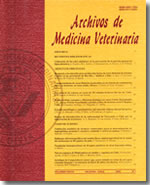Estimation of the sensitibity and specificity of two Mycoplasma suis diagnostic tests in Argentina using a Bayesian model
Main Article Content
Abstract
A prerequisite for understanding the impact of Mycoplasma suis infection on pig production and its epidemiological dynamics in infected regions, is the development of diagnostic techniques to discriminate infected from non-infected populations. The objectives of this study were to confirm the presence of M. suis infection in Argentina, and to estimate the sensitivity and specificity of both an Indirect Immunofluorescent Assay (IIFA) and a Polymerase Chain Reaction (PCR) for the detection of the agent. Blood was collected from 282 pigs belonging to 38 farms. Sensitivity (Se) and specificity (Sp) of the tests were estimated using a Bayesian model for conditional dependant results and without assuming a gold standard. PCR was estimated to be a highly sensitive (Se = 0.982, CI95% = 0.942-0.997) and highly specific (Sp = 0.946; CI95% = 0.873-0.984) method for diagnosis of M. suis infection in the assessed population. A significantly (P < 0.05) lower sensitivity (Se = 0.682, CI95% = 0.615-0.753) and specificity (Sp = 0.787, CI95% = 0.712-0.863) was estimated for the IIFA. Correlation among tests results was low, both for infected (R = 0.010, CI95% = -0.118-0.195) and non-infected (R = 0.049, CI95% = -0.133-0.407) individuals. The posterior estimate of the probability of finding an infected animal in the study population, which approximates the prevalence of the disease in the sampled animals, was 0.622 (CI95% = 0.554-0.684). The study was successful in confirming the presence of M. suis infection in Argentina and the accuracy of the PCR for the detection of the agent.

